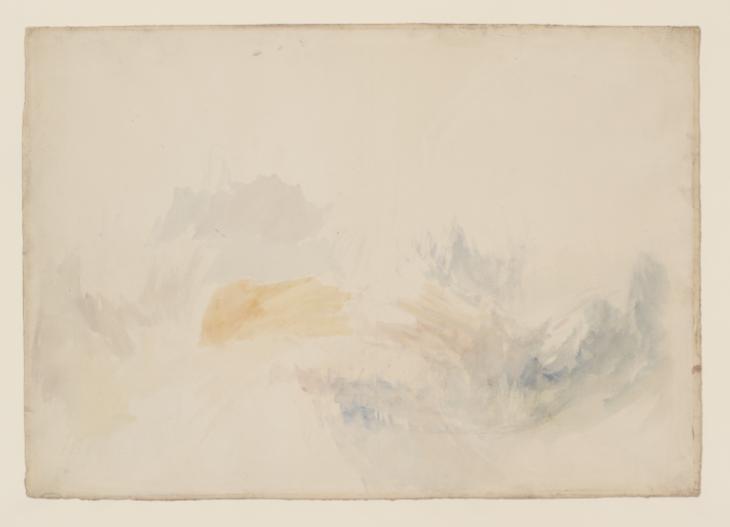Joseph Mallord William Turner A Storm (Shipwreck) c.1822-3
Joseph Mallord William Turner,
A Storm (Shipwreck)
c.1822-3
Joseph Mallord William Turner 1775–1851
A Storm (Shipwreck) c.1822–3
D25494
Turner Bequest CCLXIII 371
Turner Bequest CCLXIII 371
Watercolour on white wove paper, 488 x 694 mm
Watermark ‘J Whatman | Turkey Mills | 1822’
Inscribed in pencil ‘cclxiii.371’ bottom right
Stamped in black ‘CCLXIII 371’ bottom right
Watermark ‘J Whatman | Turkey Mills | 1822’
Inscribed in pencil ‘cclxiii.371’ bottom right
Stamped in black ‘CCLXIII 371’ bottom right
Accepted by the nation as part of the Turner Bequest 1856
References
1820
A.J. Finberg, A Complete Inventory of the Drawings of the Turner Bequest, London 1909, vol.II, p.843, CCLXIII 371, as ‘Stormy sea and mountains’, c.1820–30.
1979
Andrew Wilton, J.M.W. Turner: His Life and Work, Fribourg 1979, p.358 under no.508.
1991
Ian Warrell, Turner: The Fourth Decade: Watercolours 1820–1830, exhibition catalogue, Tate Gallery, London 1991, p.29 under no.8.
1997
Eric Shanes, Turner’s Watercolour Explorations 1810–1842, exhibition catalogue, Tate Gallery, London 1997, pp.28, 99 Appendix I ‘Marine Views Series’.
1998
Kim Sloan, J.M.W. Turner: Watercolours from the R.W. Lloyd Bequest in the British Museum, London 1998, p.86 under no.25 and note 1.
As previously recognised,1 this large ‘colour beginning’ is one of three (see also Tate D25501, D25503; Turner Bequest CCLXIII 377, 379) painted in combinations of yellow ochre and blue on uniform sheets of 1822 Whatman paper which relate to the watercolour now customarily known as A Storm (Shipwreck) (British Museum, London);2 it was exhibited at the publisher and engraver W.B. Cooke’s gallery in 1823 (no number, added during the course of the exhibition as ‘Shipwreck’,3 but advertised as ‘A Storm’4), and related to Cooke’s short-lived Marine Views print project (see the Introduction to this section). As Eric Shanes has put it, Turner used the three variant studies to ‘set out the pictorial dynamics that would flood through the most violently tempestuous seascape ever created in watercolour’5
Ian Warrell has suggested that the subject may have been inspired in part by Turner’s sea voyage up the East Coast of England and Scotland to Edinburgh in August 1822 (see Thomas Ardill’s ‘George IV’s visit to Edinburgh 1822’ section of this catalogue), during which he made many drawings of the coast, including the very rugged stretch around Dunbar Castle in the Scotch Antiquities sketchbook (Tate D13617–D13624; Turner Bequest CLXVII 18a–23).6 The apocalyptic finished design recalls earlier works such as the painting The Wreck of a Transport Ship, of 1810 (Museu Calouste Gulbenkian, Lisbon)7 and the watercolour The Loss of an East Indiaman, c.1818 (The Higgins, Bedford),8 both featuring figures in desperate straits on the steeply tilting decks of foundering vessels; see under Tate D17178 (Turner Bequest CXCVI N) for the latter, as well as being reminiscent in early, dramatic exercises in the manner of Philip James de Loutherbourg (1740–1812), such as A Rocky Shore, with Men Attempting to Rescue a Storm-Tossed Boat of 1792–3 (Tate D00392; Turner Bequest XXIII R).
Of the three studies noted initially, this is the palest and most tentative. The pale ochre area to the left of centre correlates with the sloping deck of the sinking ship in the middle distance of the finished design, with the smaller patch towards the right marking the rock buffeted by ferocious waves in the foreground.
Technical notes:
There is a vertical fold down the centre of the sheet.
Verso:
Blank; inscribed in pencil ‘cclxiii 371’ towards bottom right.
Matthew Imms
July 2016
How to cite
Matthew Imms, ‘A Storm (Shipwreck) c.1822–3 by Joseph Mallord William Turner’, catalogue entry, July 2016, in David Blayney Brown (ed.), J.M.W. Turner: Sketchbooks, Drawings and Watercolours, Tate Research Publication, February 2017, https://www

